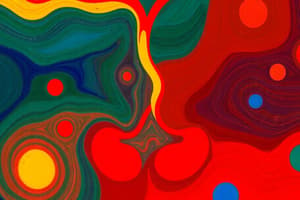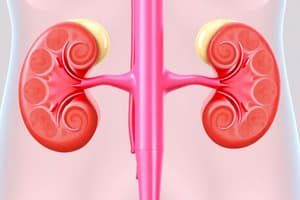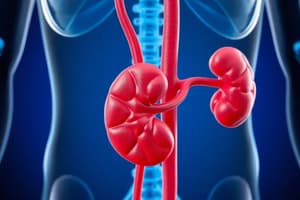Podcast
Questions and Answers
What are the two important homeostatic processes that maintain a constant internal environment in the body?
What are the two important homeostatic processes that maintain a constant internal environment in the body?
- Digestion and Respiration
- Growth and Development
- Excretion and Osmoregulation (correct)
- Circulation and Reproduction
What are the major excretory products?
What are the major excretory products?
Nitrogenous compounds, Carbon dioxide and water vapor, Bile pigments
What part of the urinary system filters blood?
What part of the urinary system filters blood?
- Bladder
- Ureters
- Kidneys (correct)
- Urethra
What is the name of the blood filtering units of the kidney?
What is the name of the blood filtering units of the kidney?
What are the three distinct regions of the kidney?
What are the three distinct regions of the kidney?
What is the function of the Loop of Henle?
What is the function of the Loop of Henle?
The kidneys filter approximately 180 liters of blood per day.
The kidneys filter approximately 180 liters of blood per day.
What is the function of the renal corpuscle?
What is the function of the renal corpuscle?
Which of the following is NOT a part of a nephron?
Which of the following is NOT a part of a nephron?
What are the two types of blood vessels associated with the nephron?
What are the two types of blood vessels associated with the nephron?
What is the function of the proximal convoluted tubule?
What is the function of the proximal convoluted tubule?
Flashcards
Excretion
Excretion
The process of removing metabolic waste products from the body.
Osmoregulation
Osmoregulation
The process of maintaining a constant osmotic pressure in the body, ensuring the balance of fluids and electrolytes.
Nitrogenous Compounds
Nitrogenous Compounds
The primary waste products of metabolism, mainly produced from protein breakdown.
Carbon Dioxide
Carbon Dioxide
Signup and view all the flashcards
Urine
Urine
Signup and view all the flashcards
Kidneys
Kidneys
Signup and view all the flashcards
Ureters
Ureters
Signup and view all the flashcards
Urinary Bladder
Urinary Bladder
Signup and view all the flashcards
Urethra
Urethra
Signup and view all the flashcards
Urination
Urination
Signup and view all the flashcards
Renal Arteries
Renal Arteries
Signup and view all the flashcards
Renal Veins
Renal Veins
Signup and view all the flashcards
Renal Cortex
Renal Cortex
Signup and view all the flashcards
Renal Medulla
Renal Medulla
Signup and view all the flashcards
Renal Pelvis
Renal Pelvis
Signup and view all the flashcards
Nephrons
Nephrons
Signup and view all the flashcards
Glomerulus
Glomerulus
Signup and view all the flashcards
Bowman's Capsule
Bowman's Capsule
Signup and view all the flashcards
Renal Corpuscle
Renal Corpuscle
Signup and view all the flashcards
Ultrafiltration
Ultrafiltration
Signup and view all the flashcards
Proximal Convoluted Tubule
Proximal Convoluted Tubule
Signup and view all the flashcards
Loop of Henle
Loop of Henle
Signup and view all the flashcards
Distal Convoluted Tubule
Distal Convoluted Tubule
Signup and view all the flashcards
Collecting Duct
Collecting Duct
Signup and view all the flashcards
Kidney Failure
Kidney Failure
Signup and view all the flashcards
Dialysis
Dialysis
Signup and view all the flashcards
Kidney Transplant
Kidney Transplant
Signup and view all the flashcards
Excretion
Excretion
Signup and view all the flashcards
Osmoregulation
Osmoregulation
Signup and view all the flashcards
Study Notes
Urinary System
- The urinary system maintains a constant internal environment through excretion and osmoregulation.
- Excretion is the removal of metabolic waste products from the body.
- Osmoregulation is the maintenance of constant osmotic conditions in the body.
Major Excretory Products
- Nitrogenous compounds: Excreted by the kidneys and through sweat.
- Carbon dioxide and water vapor: Excreted through the lungs.
- Bile pigments: Derived from the breakdown of old red blood cells (RBCs). They are excreted in feces through the digestive system.
Functions of the Urinary System
- Removal of metabolic wastes and harmful substances.
- Regulation of water, salts, and other substances in the body.
- Control of blood pH.
Structure of the Urinary System
- Kidneys: Filter blood and produce urine.
- Renal arteries: Supply blood to the kidneys.
- Renal veins: Return blood from the kidneys.
- Ureters: Transport urine from kidneys to the urinary bladder.
- Urinary bladder: Stores urine.
- Urethra: Transports urine out of the body.
Urine Formation and Excretion
- Urine is formed in the kidneys.
- Urine is drained from the kidneys via ureters to the urinary bladder.
- Urine is expelled from the body through the urethra via the process of urination.
Kidney Structure
- Cortex: Outer region of the kidney.
- Medulla: Inner region of the kidney, containing renal pyramids.
- Pelvis: Funnel-shaped structure that collects urine from the pyramids.
- Nephrons: Microscopic filtering units within the kidney. About one million per kidney. The basic structure and function units of the kidney.
Renal Cortext
- The Renal Cortex is covered by fibrous connective tissue (capsule).
- Contains blood capillaries.
Renal Medulla
- The Renal Medulla contains fine tubules and blood vessels which together form the renal pyramids.
Collecting Ducts and Urine flow
- All pyramids drain the urine to the pelvis, and then to the ureter.
Nephrons in Detail
- Located in cortex and medulla.
- Surrounded by a network of blood vessels.
Nephron Composition
- Glomerulus: Mass of thin-walled capillaries.
- Bowman's capsule (glomerular capsule): A cup-shaped structure surrounding the glomerulus.
- Renal corpuscle (malpighian corpuscle): The glomerulus + Bowman's capsule.
- Proximal convoluted tubule: Reabsorbs 90% water, glucose, amino acids, and salts - by osmosis, diffusion, and active transport and returning them to the bloodstream.
- Loop of Henle: Conserves water (descending limb permeable to water; ascending limb permeable to ions).
- Distal convoluted tubule: Controls the precise amount of water and salts reabsorbed; and controls blood pH.
- Collecting duct: Collects urine from numerous nephrons and moves it to the pelvis..
Ultrafiltration
- Ultrafiltration of the blood occurs in the renal corpuscle.
- Inside the kidney, the renal artery branches into arterioles, then into glomerulus capillaries. This increases blood pressure.
- All blood contents except larger molecules (proteins, blood cells) come out of the capillaries into Bowman’s capsule. Larger molecules remain in the capillaries.
Filtered Fluid Composition
- Filtered fluid/Filtrate contains glucose, amino acids, some hormones, nitrogenous wastes (urea, uric acid), and water.
Renal Tubules
- Renal tubules reabsorb useful materials needed by the body and return them to the bloodstream.
Kidney Filtration and Output
- Kidneys filter about 180 liters of blood per day.
- Produce 1 to 1.5 liters of urine per day.
Nephron Function Summary
- Renal corpuscle: Blood filtration.
- Proximal convoluted tubule: Reabsorption of useful substances.
- Loop of Henle: Water conservation.
- Distal convoluted tubule: Precise control of water and salt reabsorption, and pH control.
- Collecting duct: Carries the filtered fluid to the pelvis.
Studying That Suits You
Use AI to generate personalized quizzes and flashcards to suit your learning preferences.




